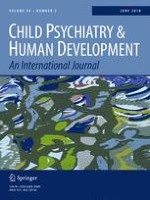30-09-2017 | Original Article
Ethnicity’s Role in the Relationship Between Anxiety and Negative Interpretation Bias Among Clinically Anxious Youth: A Pilot Study
Gepubliceerd in: Child Psychiatry & Human Development | Uitgave 3/2018
Log in om toegang te krijgenAbstract
Negative interpretation bias, a correlate of anxiety, is defined as an individual’s tendency to interpret ambiguous events as negative or threatening. The current study examined associations between interpretation bias and anxiety symptoms in clinically anxious youth and potential moderators of these relationships. Thirty anxious youth and their parents participated in a clinical interview and reported on child anxiety symptoms. Youth completed implicit, explicit-personally irrelevant, and explicit-personally relevant interpretation bias measures. Child-reported anxiety was only associated with negative interpretation bias on the explicit-personally relevant measure and parent-reported social anxiety was negatively associated with positive bias on this measure. Hispanic individuals displayed marginally higher anxiety symptoms and significantly more intense negative interpretation on the implicit measure. While this pilot study revealed preliminary findings that Hispanic ethnicity may play a role in relationships between interpretation bias and anxiety, future work may further elucidate associations between interpretation bias, anxiety, and ethnicity in anxious youth.
